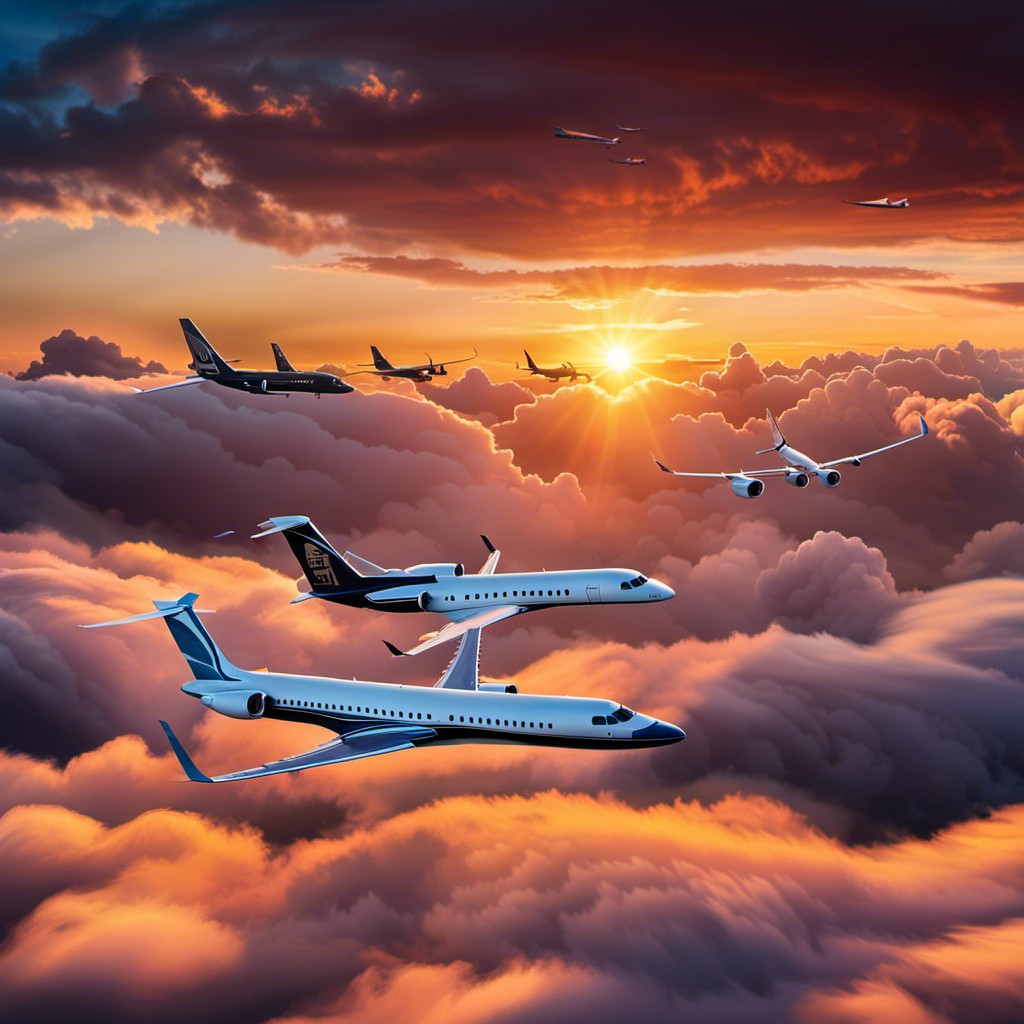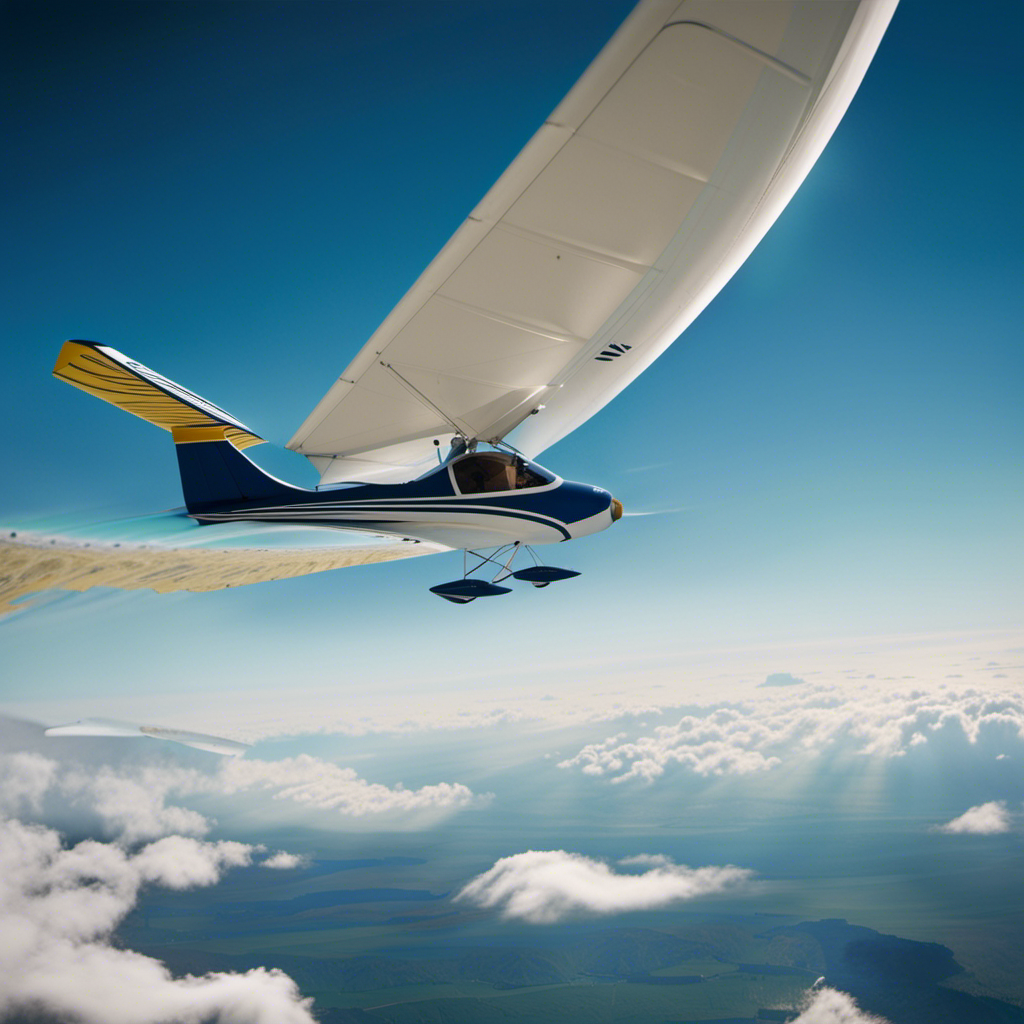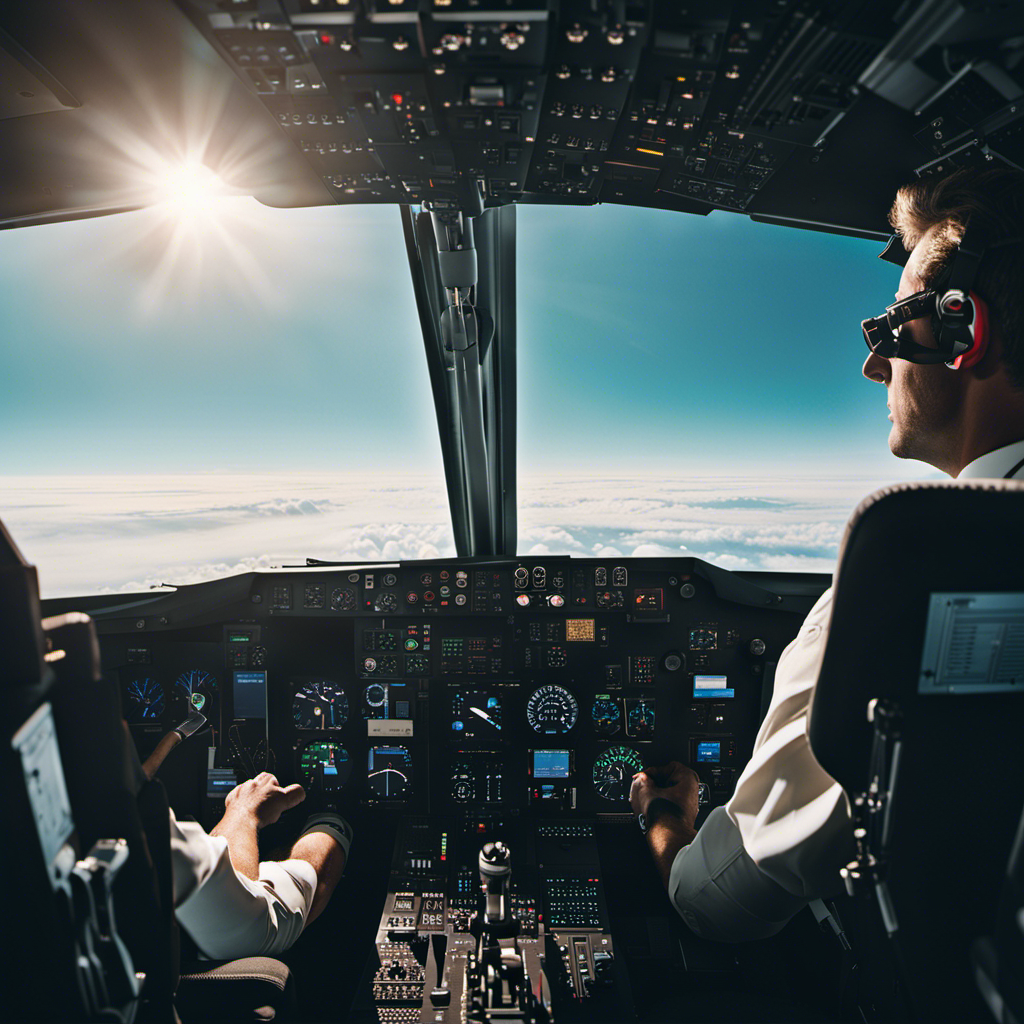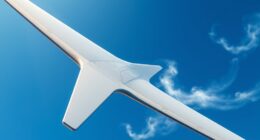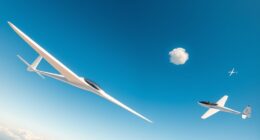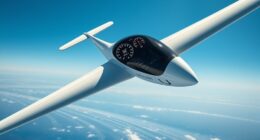I have always been curious about which type of pilot makes the most money. After conducting thorough research and analysis from various sources, I have discovered some intriguing results.
From commercial airline pilots to military pilots, corporate pilots to helicopter pilots, there are several factors that contribute to their earning potential. In this article, we will delve into the world of aviation salaries, examining different types of pilots and the factors that determine their income.
Get ready to uncover the truth about the highest-earning pilots in the industry.
Key Takeaways
- Commercial airline pilots have the highest earning potential, with captains earning over $200,000 per year.
- Military pilot salaries vary based on rank and years of service, with different types of military pilot careers available.
- Corporate pilots have varying salary ranges and perks depending on the company and their experience, with the opportunity to travel and work in luxurious environments.
- Helicopter pilots can earn between $50,000 to over $100,000 per year, with job opportunities in medical transport, tourism, and law enforcement.
Commercial Airline Pilots
Commercial airline pilots typically make the most money compared to other types of pilots. When considering salary comparison, it is important to note that commercial airline pilots have higher earning potential due to the nature of their work. They are responsible for transporting passengers and cargo safely and efficiently, which requires a high level of skill and expertise. As a result, these pilots are compensated accordingly.
The salary of a commercial airline pilot is influenced by various factors such as experience, seniority, and the size of the airline. Starting salaries for commercial airline pilots can range from around $50,000 to $100,000 per year. However, as pilots gain more experience and move up the ranks, their earnings increase significantly. Captains, who are the highest-ranking pilots in the airline, can earn well over $200,000 per year.
In addition to competitive salaries, commercial airline pilots also benefit from career growth opportunities. As they accumulate flight hours and gain experience, they can advance to higher positions within the airline, such as becoming a trainer or an instructor. Some pilots may also have the opportunity to transition into management roles, further expanding their earning potential.
Transitioning to the subsequent section about military pilots, it is important to note that while commercial airline pilots generally make more money, military pilots have their own unique set of benefits and opportunities.
Military Pilots
When it comes to military pilots, there are several key points to consider.
First, the salary range and benefits for military pilots can vary depending on factors such as rank and years of service.
Second, there are different types of military pilot careers, including fighter pilots, transport pilots, and helicopter pilots, each with their own unique responsibilities and challenges.
Lastly, becoming a military pilot requires rigorous training and qualifications. This includes a combination of classroom instruction, simulator training, and flight hours, as well as meeting physical and medical standards.
Salary Range and Benefits
The highest paying pilot job is typically that of an airline pilot due to their salary range and benefits. Airline pilots have the potential to earn a substantial income, often exceeding six figures. In addition to their salary, airline pilots enjoy a range of benefits that contribute to their overall compensation package. These benefits may include health insurance, retirement plans, and travel perks for themselves and their families.
When comparing salaries, it is important to consider factors such as experience level, seniority, and the size of the airline. However, it is worth noting that while airline pilots may earn higher salaries, job satisfaction can vary among pilots in different sectors.
- Airline pilots have a higher salary range compared to other types of pilots.
- They often receive additional benefits such as health insurance and retirement plans.
- Travel perks for both the pilot and their family are common in the airline industry.
- Salary can be influenced by factors such as experience level and seniority.
- While the salary may be higher, job satisfaction can vary among pilots in different sectors.
Moving on to types of military pilot careers, the opportunities available are diverse and offer unique challenges.
Types of Military Pilot Careers
There are various types of military pilot careers available, each offering its own set of challenges.
Military pilot careers can be divided into different branches, such as the Air Force, Navy, or Army. Each branch has its own unique advantages and challenges.
For example, Air Force pilots often have access to advanced fighter jets and advanced technology, but they may also face longer deployments and more rigorous training.
Navy pilots, on the other hand, have the opportunity to land and take off from aircraft carriers, but they must also be comfortable with landing on a moving platform.
Army pilots may fly helicopters and transport aircraft, providing crucial support to ground troops, but they may also face more dangerous and high-stress situations.
Overall, military pilot careers require a high level of skill, dedication, and the ability to perform under pressure.
Transitioning into the subsequent section about ‘training and qualifications’, it is important to understand the demanding requirements needed to become a military pilot.
Training and Qualifications
To become a military pilot, it’s essential to meet rigorous training and qualification standards. The training methods for military pilots are designed to ensure the highest level of proficiency in flying and combat skills. These methods include classroom instruction, flight simulators, and extensive flight hours in various aircraft.
Certification requirements for military pilots are also stringent, with candidates needing to pass physical fitness tests, written exams, and flight evaluations. Additionally, they must meet medical standards and possess excellent vision and hearing. The certification process is thorough and comprehensive, ensuring that only the most competent individuals become military pilots.
Transitioning to the next section about corporate pilots, it’s interesting to note that while the training and qualification standards may differ, the commitment to excellence remains a common trait among all pilots.
Corporate Pilots
When it comes to discussing the role of corporate pilots, there are several key points to consider.
Firstly, the salary range and perks for this position can vary significantly depending on the company and the level of experience of the pilot.
Secondly, the job responsibilities and requirements of a corporate pilot often involve not only flying the aircraft but also managing the overall operation and ensuring the safety of the passengers.
Lastly, while there are many advantages to being a corporate pilot, such as the opportunity to travel to different destinations and work in a luxurious environment, there are also challenges, such as the demanding schedules and the need to constantly stay updated with the latest aviation regulations and technology.
Salary Range and Perks
Pilots who have extensive experience and training can earn the highest salaries in the aviation industry. These professionals are often sought after by airlines and private jet companies for their expertise and skill. Here is a breakdown of the salary range and job perks that come with being a highly experienced pilot:
-
Salary Range: Experienced pilots can expect to earn anywhere from $100,000 to $250,000 or more per year. This range can vary depending on factors such as the type of aircraft flown, the company they work for, and their level of seniority within the organization.
-
Job Perks: Along with a handsome salary, experienced pilots often enjoy a range of perks that add to the overall appeal of the job. These perks may include flexible schedules, generous vacation allowances, health and retirement benefits, and the opportunity to travel to exciting destinations around the world.
Transitioning into the next section about job responsibilities and requirements, it is important for pilots to not only have a high earning potential and attractive perks but also be well-equipped to handle the responsibilities and meet the requirements of the job.
Job Responsibilities and Requirements
Moving on from discussing the salary range and perks of being a pilot, let’s delve into the job responsibilities and requirements of this profession.
As a pilot, my primary responsibility is to safely operate an aircraft and ensure the well-being of my passengers. This involves thorough pre-flight inspections, following air traffic control instructions, and making critical decisions in emergency situations. Additionally, pilots are responsible for planning flight routes, monitoring weather conditions, and communicating with the cabin crew.
To become a pilot, one must meet certain requirements. These typically include obtaining a private pilot’s license, completing flight training programs, and accumulating a specific number of flight hours. Additionally, a commercial pilot’s license and instrument rating are often required for career advancement.
It’s important to note that the aviation industry is experiencing steady job growth, with an increasing demand for pilots in the coming years. To meet this demand, various training programs are available, offering aspiring pilots the opportunity to gain the necessary skills and knowledge.
Transition: Now that we have explored the job responsibilities and requirements of being a pilot, let’s move on to the advantages and challenges of this role.
Advantages and Challenges of the Role
As a pilot, you’ll face various challenges, such as adverse weather conditions, long hours of flying, and managing the safety of passengers and crew. However, there are also many advantages to this role.
One of the main advantages is the ability to travel and see the world from a unique perspective. Pilots also have the opportunity to work in a dynamic and fast-paced environment, constantly adapting to changing conditions and situations. Another advantage is the sense of accomplishment that comes from mastering the skills required to safely operate an aircraft.
However, it’s important to acknowledge that being a pilot also comes with its fair share of challenges. These challenges include the high level of responsibility, the need for constant training and certification, and the potential for a demanding work schedule. Despite these challenges, the rewards and opportunities offered by a career as a pilot are well worth it.
Transitioning to the next section about helicopter pilots, it’s important to understand the unique aspects of their role.
Helicopter Pilots
Helicopter pilots aren’t known for their high salaries in comparison to other types of pilots. However, despite the financial aspect, the demand for helicopter pilots is on the rise, making it an attractive career option for those passionate about aviation.
Here are some key points to consider:
-
Helicopter Pilot Demand:
-
The demand for helicopter pilots is increasing due to the growing need for emergency medical services, search and rescue operations, and aerial firefighting.
-
Additionally, the oil and gas industry heavily relies on helicopter pilots for transportation to offshore platforms.
-
Helicopter Pilot Training:
-
Becoming a helicopter pilot requires specialized training and certification. This includes flight hours, ground school, and passing written and practical exams.
-
Training programs are offered by flight schools and the military, providing aspiring pilots with the necessary skills and knowledge to safely operate helicopters.
Transitioning to the next topic, cargo and freight pilots play a crucial role in the transportation industry.
Cargo and Freight Pilots
Cargo and freight pilots have the responsibility of transporting goods and materials safely and efficiently. With the global increase in e-commerce and international trade, the demand for freight pilots has been steadily rising. This high demand is reflected in cargo pilot salaries, which are generally quite competitive.
On average, cargo pilots can earn around $77,200 to $200,000 per year, depending on factors such as experience, type of aircraft flown, and the company they work for.
The salaries of cargo pilots are influenced by several factors. Firstly, the complexity and risk associated with flying cargo planes often result in higher wages compared to other pilot positions. Additionally, cargo pilots often work long hours and may be required to fly during unconventional hours, which can also contribute to higher salaries.
The demand for freight pilots is expected to continue growing in the coming years, as the global economy expands and online shopping becomes increasingly popular.
As cargo and freight pilots play a crucial role in the transportation industry, their expertise and skills are highly valued. However, some pilots may choose to pursue further career progression and become airline transport pilots (ATPs). ATPs are responsible for flying passengers on commercial airlines and typically receive higher salaries compared to cargo pilots.
Despite this potential career transition, cargo and freight pilots remain an integral part of the aviation industry, facilitating the movement of goods and materials around the world.
Airline Transport Pilots (ATPs)
If you’re considering a career as an airline transport pilot, you can expect higher salaries compared to cargo pilots. As an ATP, your qualifications and expertise will enable you to earn a more lucrative income. Airline pilot salaries vary depending on factors such as experience, airline size, and location. To give you a better understanding of the potential earnings, I have gathered some data in the table below:
| Airline | Average Annual Salary (USD) | Qualifications Required |
|---|---|---|
| Major | $121,408 | ATP License, 1,500 flight hours |
| Regional | $78,759 | ATP License, 1,000 flight hours |
| Charter | $85,860 | ATP License, 500 flight hours |
| Cargo | $72,288 | ATP License, 1,000 flight hours |
As you can see, airline transport pilots working for major airlines tend to earn the highest salaries, followed by regional and charter pilots. Cargo pilots, although still well-compensated, generally earn slightly less due to the nature of their operations. To become an ATP, you must meet rigorous qualifications, including obtaining an ATP license and accumulating a specific number of flight hours. These requirements ensure that ATPs have the necessary skills and experience to safely operate commercial aircraft.
Now, let’s transition to the next section, where we will explore the earnings and qualifications of agricultural pilots.
Agricultural Pilots
Moving on from Airline Transport Pilots (ATPs), another type of pilot that deserves attention in terms of salary and training is the Agricultural Pilot. Agricultural pilots play a crucial role in the farming industry by using aircraft to spray crops with fertilizers, pesticides, and herbicides.
When it comes to salary, agricultural pilots can earn a decent income. The average salary for agricultural pilots in the United States is around $82,000 per year. However, it is important to note that this figure can vary depending on factors such as experience, location, and the size of the agricultural operation. Some agricultural pilots who work for large companies or own their own businesses can earn significantly higher salaries.
In terms of training, becoming an agricultural pilot requires specialized instruction and certifications. Pilots typically need to complete a specialized agricultural pilot training program, which covers topics such as crop dusting techniques, safety procedures, and chemical application. Additionally, pilots must obtain a commercial pilot’s license and an agricultural aircraft rating.
Transitioning to the next section about flight instructors, it is important to explore the role they play in shaping the skills and knowledge of aspiring pilots.
Flight Instructors
Transitioning to flight instructors, they play a crucial role in teaching aspiring pilots the necessary skills and knowledge to become successful in the aviation industry. Flight instructors are highly skilled pilots who have obtained the necessary certifications and qualifications to train others. They not only impart technical knowledge but also instill the discipline and professionalism required in the aviation field.
When it comes to flight instructor pay, it can vary depending on factors such as experience, location, and the type of flight school. On average, flight instructors earn around $30,000 to $60,000 per year. However, some instructors who work at prestigious flight schools or have extensive experience can earn over $100,000 annually. It is worth noting that flight instructor pay is typically lower compared to other pilot positions, but the job offers the opportunity to gain valuable experience and build flight hours.
To become a flight instructor, one must meet certain qualifications. These typically include holding a Commercial Pilot License and having a minimum number of flight hours, usually around 250-300 hours. Additionally, instructors must pass a written exam and a flight test administered by the aviation authority. Having good communication and teaching skills is also important as flight instructors must effectively convey complex information to their students.
Transitioning into the next section about ‘air show pilots’, these pilots are known for their impressive aerobatic displays and precision flying skills.
Air Show Pilots
Being an air show pilot is an exhilarating career choice that offers a unique blend of excitement and skill. When it comes to salary range and performance fees, air show pilots have the potential to earn a substantial income, with top performers commanding high fees for their breathtaking displays.
However, this profession requires a high level of expertise and precision flying skills, as pilots must navigate through intricate maneuvers and execute them flawlessly to captivate audiences. The air show circuit also presents its fair share of thrills and challenges, including the constant need for innovation and the pressure to perform at the highest level while ensuring safety remains the top priority.
Salary Range and Performance Fees
You’ll be interested to know that the salary range and performance fees are key factors in determining which type of pilot makes the most. Performance based bonuses can significantly impact a pilot’s earnings, especially for those in high-demand sectors such as commercial airlines or private jet companies. Other factors affecting pilot salaries include the type of aircraft they fly, their level of experience, and the region in which they work. To give you a better understanding of the salary differences, here’s a table showcasing the average annual salaries for different types of pilots:
| Type of Pilot | Average Annual Salary |
|---|---|
| Airline Pilot | $120,000 – $200,000 |
| Corporate Pilot | $80,000 – $150,000 |
| Helicopter Pilot | $60,000 – $100,000 |
As you can see, airline pilots tend to earn the highest salaries, followed by corporate pilots and helicopter pilots. Now let’s delve into the skills and expertise required for each type of pilot.
Skills and Expertise Required
To excel in the aviation industry, it’s important to possess a diverse skill set and expertise that align with the demands of the profession.
As a pilot, there are certain skills required and expertise needed to navigate the skies with confidence and proficiency.
Firstly, a strong knowledge of aviation regulations and safety procedures is essential. This includes understanding airspace restrictions, weather patterns, and emergency protocols.
Additionally, pilots must have excellent communication skills to effectively communicate with air traffic control and passengers. They must also possess sharp decision-making abilities, as split-second decisions can have significant consequences.
Furthermore, technical proficiency in operating aircraft systems and navigation equipment is crucial.
Overall, the aviation industry demands pilots with a wide range of skills and expertise to ensure safe and efficient flights.
As we transition to the subsequent section about the thrills and challenges of the air show circuit, it becomes apparent that these skills and expertise are put to the test in exhilarating and demanding ways.
Thrills and Challenges of the Air Show Circuit
The air show circuit offers exhilarating challenges that put pilots’ skills and expertise to the test in thrilling ways. Air shows are known for their jaw-dropping maneuvers and heart-stopping stunts that captivate audiences around the world. However, there is a delicate balance between delivering thrills and ensuring safety in these events.
Pilots must carefully plan and execute their routines, taking into account factors such as altitude, speed, and proximity to the crowd. Additionally, weather conditions play a crucial role in air show performances. Strong winds, rain, or low visibility can significantly impact a pilot’s ability to perform certain maneuvers safely. Therefore, pilots must constantly monitor weather forecasts and make necessary adjustments to their routines.
As we transition into the next section, it is worth noting that the rise of drone pilots in the aviation industry has brought about a new set of challenges and opportunities.
Drone Pilots
When it comes to the field of drone piloting, there are several key points to consider.
First, let’s talk about the salary range and market growth. The demand for skilled drone pilots has been steadily increasing, leading to a promising job market and potential for higher salaries.
Additionally, it’s important to discuss the licensing and regulations that come with this profession. As the drone industry continues to evolve, there are strict regulations in place to ensure safety and compliance.
Lastly, we should explore the various industries and applications where drone pilots are in high demand. From aerial photography and videography to agriculture and infrastructure inspections, the possibilities for drone pilots are vast and diverse.
Salary Range and Market Growth
You can expect a wide salary range and promising market growth as a pilot.
In the aviation industry, salaries for pilots vary depending on factors such as experience, type of aircraft, and the airline or company they work for. However, overall, the salary growth for pilots has been steady in recent years.
With the increasing demand for air travel and the retirement of older pilots, the market is projected to continue to grow. This means that there will be more job opportunities and potentially higher salaries for pilots in the future.
As we delve into the topic of licensing and regulations, it is important to understand the current salary landscape and market demand for pilots.
Licensing and Regulations
To navigate the world of aviation, it’s crucial for pilots to understand licensing and regulations. These requirements ensure that pilots are qualified and competent to operate aircraft safely. In order to obtain a pilot’s license, individuals must meet certain qualifications and undergo thorough training. The Federal Aviation Administration (FAA) sets the standards and regulations for pilot licensing in the United States. They require pilots to have a minimum number of flight hours, pass written and practical exams, and meet medical and age requirements. The table below provides an overview of the different types of pilot licenses and their corresponding qualifications:
| License Type | Qualifications |
|---|---|
| Private Pilot | Minimum age of 17, 40 hours of flight time, pass written and practical exams |
| Commercial Pilot | Minimum age of 18, 250 hours of flight time, pass written and practical exams |
| Airline Transport Pilot | Minimum age of 23, 1,500 hours of flight time, pass written and practical exams |
Understanding these licensing and regulatory requirements is essential for aspiring pilots to pursue a career in aviation. It ensures that they possess the necessary skills and knowledge to safely operate aircraft. Moving forward, let’s explore the industries and applications for drone pilots.
Industries and Applications for Drone Pilots
The drone industry offers numerous opportunities for pilots to work in a variety of industries and applications. As a drone pilot, I have seen firsthand the wide range of sectors that rely on drone technology for their operations.
Here are some of the industries and applications where drone pilots are in high demand:
-
Photography and videography:
-
Aerial photography for real estate listings and events.
-
Cinematic shots for movies and commercials.
-
Agriculture:
-
Crop monitoring and analysis for precision farming.
-
Pest control and crop spraying.
-
Construction and infrastructure:
-
Surveying and mapping of construction sites.
-
Inspection of bridges, buildings, and other structures.
-
Energy and utilities:
-
Inspection of power lines and wind turbines.
-
Monitoring of oil and gas pipelines.
These are just a few examples of the diverse industries and applications that drone pilots can explore. The demand for skilled and licensed pilots is only expected to grow as the technology advances and more industries recognize the benefits of incorporating drones into their operations.
Frequently Asked Questions
What is the average salary for commercial airline pilots?
The average salary for commercial airline pilots is influenced by various factors, such as experience, airline size, and geographical location. These factors play a significant role in determining the salary range for pilots in this field.
How many years of experience does it take to become a military pilot?
It typically takes several years to become a military pilot, as it requires completing a rigorous training program. The exact length can vary depending on the branch of the military. Additionally, there is usually a minimum age requirement to become a military pilot.
What are the typical responsibilities of a corporate pilot?
As a corporate pilot, my typical responsibilities include managing flight operations, ensuring passenger safety, and maintaining the aircraft. With an average salary of $147,220 for commercial airline pilots, it’s a rewarding career choice.
Are helicopter pilots required to have any specialized training?
Yes, helicopter pilots are required to have specialized training and licensing. They need to complete a specific training program that focuses on the unique skills and knowledge needed to safely operate a helicopter.
What is the demand for cargo and freight pilots in the industry?
The demand for cargo and freight pilots is high, with many career opportunities available in the industry. Cargo pilots play a crucial role in transporting goods and materials, making it a lucrative and rewarding career path.
Conclusion
In conclusion, when it comes to the highest earning pilots, commercial airline pilots take the lead. With their extensive training and experience, they navigate through the skies, transporting passengers safely and efficiently.
Just like a skilled captain steering a ship through treacherous waters, these pilots command their aircraft with precision and expertise. Their salaries, which can reach up to $300,000 annually, reflect the responsibilities they shoulder and the invaluable service they provide.
So, if you’re looking to soar to new financial heights, consider a career as a commercial airline pilot.
